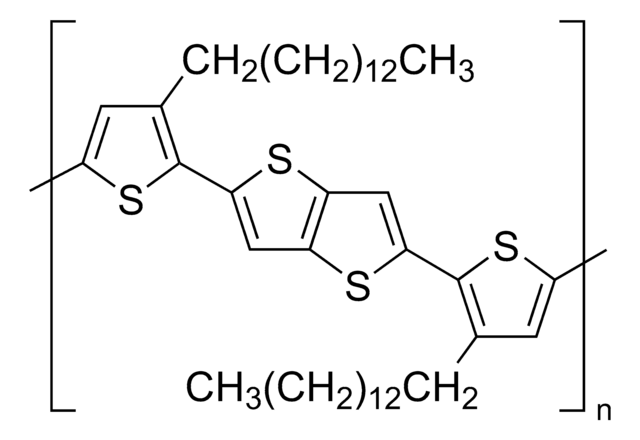推荐产品
描述
Band gap: 1.9 eV
形狀
solid
分子量
average Mw 100,000-140,000
損耗
0.5 wt. % TGA, 409 °C
mp
270-300 °C
轉變溫度
Tm >400 °C
λmax
576 nm
軌道能量
HOMO -5.5 eV
LUMO -3.6 eV
OPV器件效能
ITO/MoO3-Al/PCDTBT:PC71BM/MoO3/Al
ITO/PEDOT:PSS/PCDTBT:PC71BM (1:4)/TiOxAl
ITO/PEDOT:PSS/PCDTBT:PC71BM/Al
半導體屬性
P-type (mobility=6×10−5 cm2/V·s)
正在寻找类似产品? 访问 产品对比指南
一般說明
應用
儲存類別代碼
11 - Combustible Solids
水污染物質分類(WGK)
WGK 3
閃點(°F)
Not applicable
閃點(°C)
Not applicable
其他客户在看
商品
The development of high-performance conjugated organic molecules and polymers has received widespread attention in industrial and academic research.
Optoelectronic devices such as light-emitting diodes (LEDs), solar cells, and light-emitting field effect transistors (FETs) that utilize organic materials as their light harvesting and/or charge transporting component have been the subject of much academic and commercial attention.
Organic photovoltaics (OPVs) represent a low-cost, lightweight, and scalable alternative to conventional solar cells. While significant progress has been made in the development of conventional bulk heterojunction cells, new approaches are required to achieve the performance and stability necessary to enable commercially successful OPVs.
There is widespread demand for thin, lightweight, and flexible electronic devices such as displays, sensors, actuators, and radio-frequency identification tags (RFIDs). Flexibility is necessary for scalability, portability, and mechanical robustness.
我们的科学家团队拥有各种研究领域经验,包括生命科学、材料科学、化学合成、色谱、分析及许多其他领域.
联系客户支持
![聚 [2,6′]-4,8-二(5-乙基己基噻吩)苯并 [1,2-b;3,3-b] 二噻吩 ] {3-氟-2 [(2-乙基己基)羰基] 噻吩 [3,4-b] 噻吩二基 })](/deepweb/assets/sigmaaldrich/product/structures/187/203/ca94f947-403e-4832-8656-fc754d4148f5/640/ca94f947-403e-4832-8656-fc754d4148f5.png)
![聚[(9,9-二正辛基芴基-2,7-二基)-alt-(苯并[2,1,3]噻二唑-4,8-二基)] average Mn ≤25000](/deepweb/assets/sigmaaldrich/product/structures/428/661/1c4ebb98-9d51-48c0-96c7-e556ca425aa4/640/1c4ebb98-9d51-48c0-96c7-e556ca425aa4.png)



![[6,6]-苯基 C71 丁酸甲酯,异构体混合物 99%](/deepweb/assets/sigmaaldrich/product/structures/716/624/9fb9f2f0-ae99-429f-8d3a-b12267976a4d/640/9fb9f2f0-ae99-429f-8d3a-b12267976a4d.png)



![聚[(9,9-二辛基芴基-2,7-二基)-co-并噻吩] 99.9%](/deepweb/assets/sigmaaldrich/product/structures/309/000/8b4a3f54-7765-4aca-96c4-74ce328d455d/640/8b4a3f54-7765-4aca-96c4-74ce328d455d.png)